Emerging trends redefining multichannel customer experience
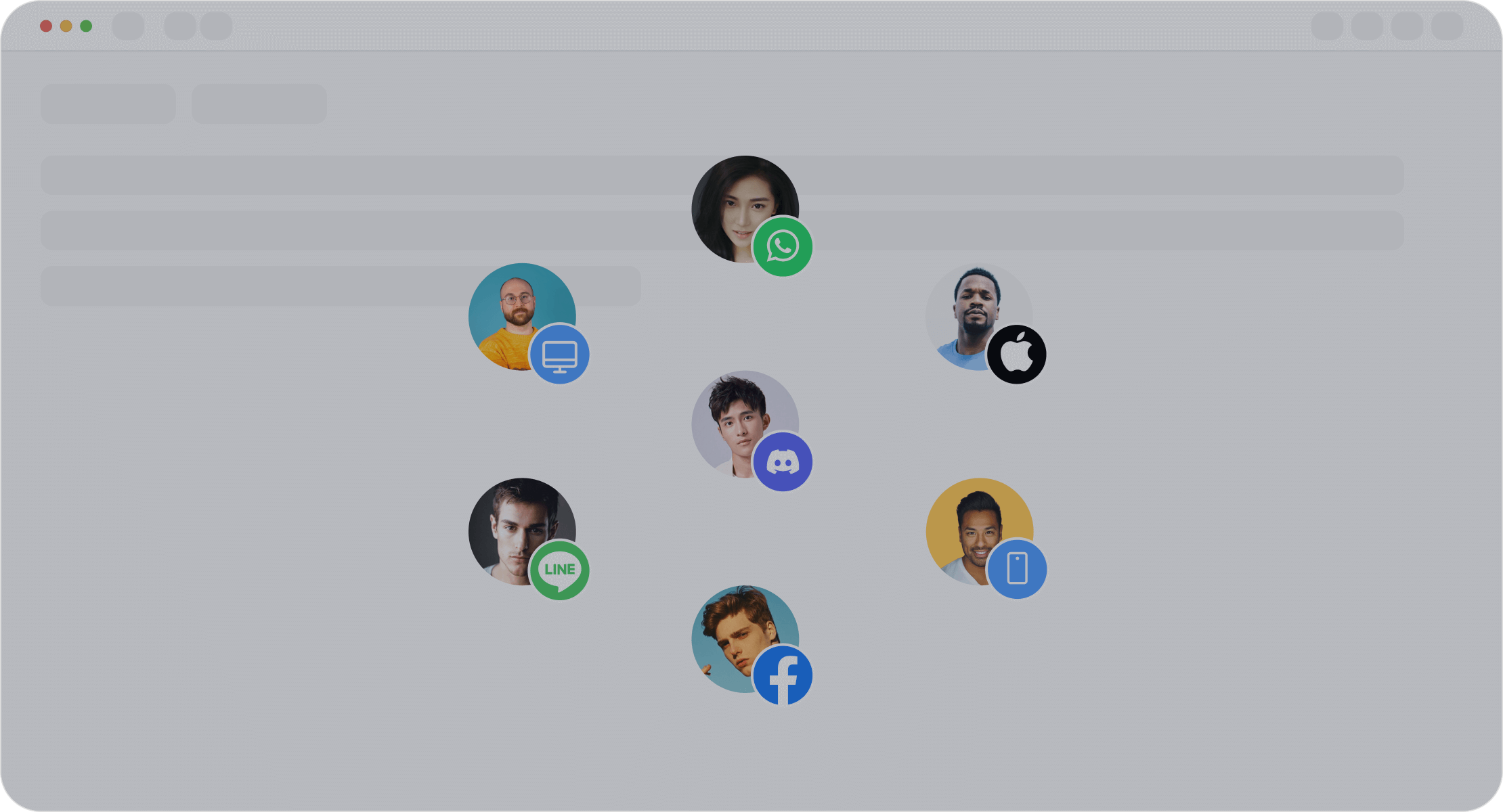
Brands face urgent pressure to adapt as multichannel customer experience rapidly evolves in 2025. AI-driven automation, hyper-personalization, and omnichannel integration now define leading customer experience trends. Companies like Sobot use Sobot AI and Sobot call center solutions to connect with customers on every channel. Industry reports show AI handles 95% of customer interactions and can boost customer lifetime value by up to 30%. The chart below highlights the impact of these trends on customer loyalty and business growth.
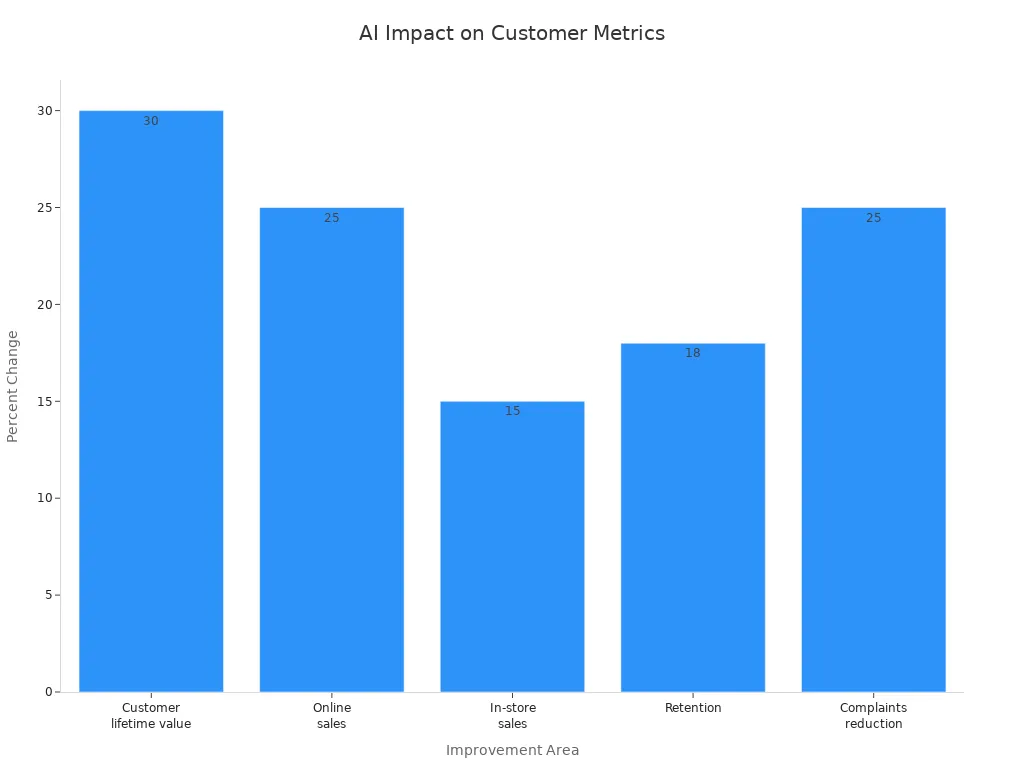
Companies must ask themselves: Are their current strategies ready to meet rising customer expectations?
Multichannel Customer Experience in 2025
Definition and Evolution
The multichannel customer experience has changed dramatically over the past decade. In the early days, companies offered support through separate channels like email, SMS, social media, and mobile apps. Customers often faced disconnected journeys because each channel operated in isolation. As digital customer experience matured, businesses recognized the need to unify these touchpoints. Today, the focus has shifted to integrating data and delivering seamless, personalized interactions across every channel. AI now plays a central role, enabling proactive support and journey orchestration. Digital transformation tools, such as CRM systems and AI-powered chatbots, help companies centralize customer data and automate responses. This evolution marks a shift from managing multiple channels to creating a cohesive, data-driven, and anticipatory customer experience. The customer experience landscape now demands unified, humanized, and proactive engagement.
Key Challenges
Brands face several challenges in delivering a seamless multichannel customer experience in 2025.
- Organizational silos often fragment customer journeys and block information flow.
- Cross-functional collaboration becomes essential, but many teams still lack shared objectives.
- Companies struggle to centralize customer data, making real-time personalization difficult.
- Adapting to rapid changes in digital customer experience requires agile management and ongoing employee training.
- Monitoring key CX metrics, such as satisfaction and retention, remains a priority for continuous improvement.
Customers expect unified experiences across all channels. Businesses must invest in consolidating CX tools and data to meet these expectations. The complexity of digital customer experience delivery increases as more teams get involved.
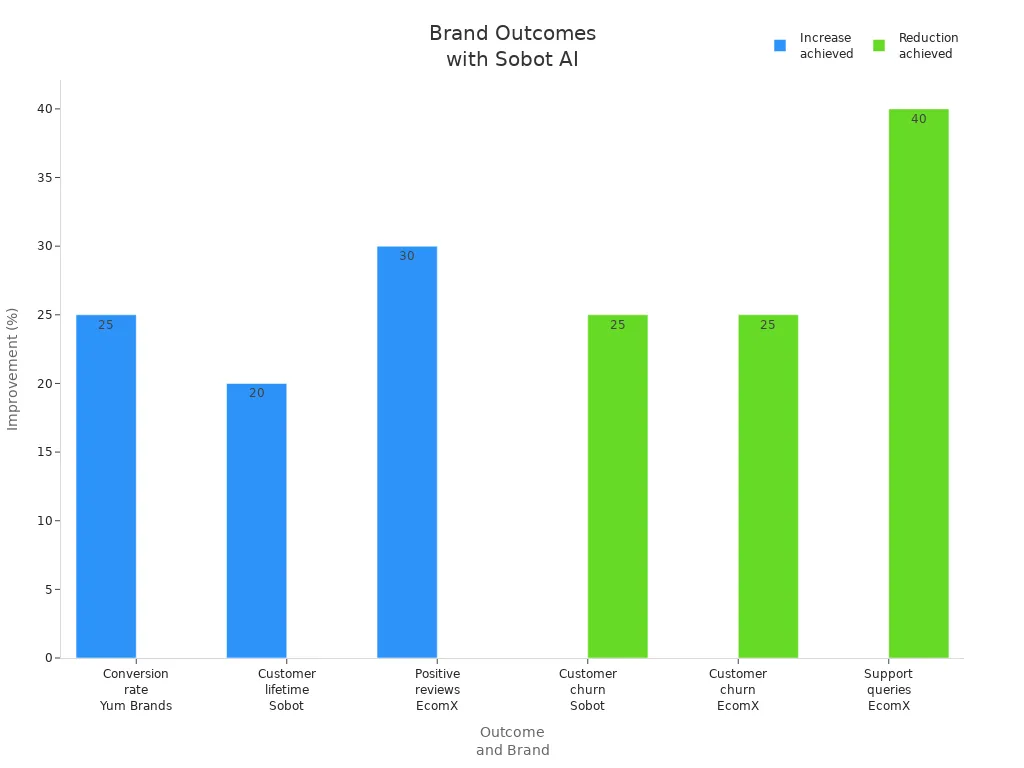
Sobot’s Approach
Sobot addresses these challenges with a hybrid model that blends AI-powered automation and human expertise. Sobot’s unified platform integrates voice, chat, email, and social media, allowing customers to interact on their preferred channels. AI-driven features, such as sentiment analysis and predictive support, automate routine tasks and personalize every interaction. This approach reduces first response times by 37% and speeds up ticket resolution by 52%. Sobot’s solutions help brands increase conversion rates, boost customer lifetime value, and reduce churn. By combining advanced technology with a customer-centric mission, Sobot delivers a digital customer experience that adapts to evolving needs and supports business growth.
Customer Experience Trends Shaping the Future
AI and Automation
AI and automation stand at the center of customer experience trends for 2025. Industry analysts predict that autonomous AI agents will transform customer engagement by handling routine tasks, reducing wait times, and improving operational efficiency. Companies now deploy AI-powered chatbots and virtual assistants to provide 24/7 support, ensuring customers receive instant responses at any time. Sobot Live Chat, for example, uses AI to automate responses, route inquiries to the right agent, and analyze customer sentiment in real time. This approach not only speeds up resolution but also personalizes every interaction.
A recent study shows that AI and automation deliver measurable results:
| Aspect | Evidence / Impact |
|---|---|
| Call Handling Time Reduction | AI-powered automation led to a 30% reduction in average call handling time in a financial services company. |
| Customer Satisfaction Increase | Customer satisfaction scores improved by 25% after AI implementation. |
| Automation of Routine Queries | 40% of routine customer queries were automated by AI in a telecom case study. |
| AI-Powered Call Routing | AI routes calls to the most suitable agent, reducing transfers and improving resolution times. |
| Real-Time Agent Assistance | AI suggests responses during calls, enhancing accuracy and consistency. |
| Sentiment Analysis | AI detects customer emotions and adjusts responses to increase empathy and engagement. |
| Predictive Analytics | AI anticipates customer needs, enabling proactive support and personalized recommendations. |
| 24/7 Availability | AI chatbots and voice assistants provide round-the-clock customer support. |
| Operational Efficiency | AI frees human agents from repetitive tasks, allowing focus on complex issues, improving efficiency. |
| Data-Driven Insights | AI analyzes vast interaction data to uncover patterns, optimize strategies, and improve training. |
AI and machine learning-powered customer service now enables brands to automate up to 40% of routine queries, freeing agents to focus on complex issues. Sobot’s analytics-driven approach leverages over 150 indicators to optimize service and provide actionable insights. This data-driven strategy helps companies predict customer needs, personalize communication, and improve CX outcomes. As a result, businesses see higher customer satisfaction, faster response times, and lower operational costs.
AI and automation are not just predictions—they are the foundation of modern CX strategies, driving efficiency and delivering personalized solutions at scale.
Hyper-Personalization
Hyper-personalization has become a defining feature of customer experience predictions for 2025. Brands move beyond basic personalization to deliver hyper-personalized experiences powered by AI and real-time analytics. These experiences anticipate customer needs, tailor recommendations, and create emotional connections that drive loyalty.
Industry leaders highlight several key predictions for hyper-personalization:
- Hyper-personalized experiences powered by AI and machine learning will become essential, moving beyond basic personalization to predictive, tailored customer interactions.
- Brands will focus on systemic improvements to address root causes of CX issues, enabling scalable continuous improvement.
- Building trust through active listening, accountability, and transparency will set brands apart.
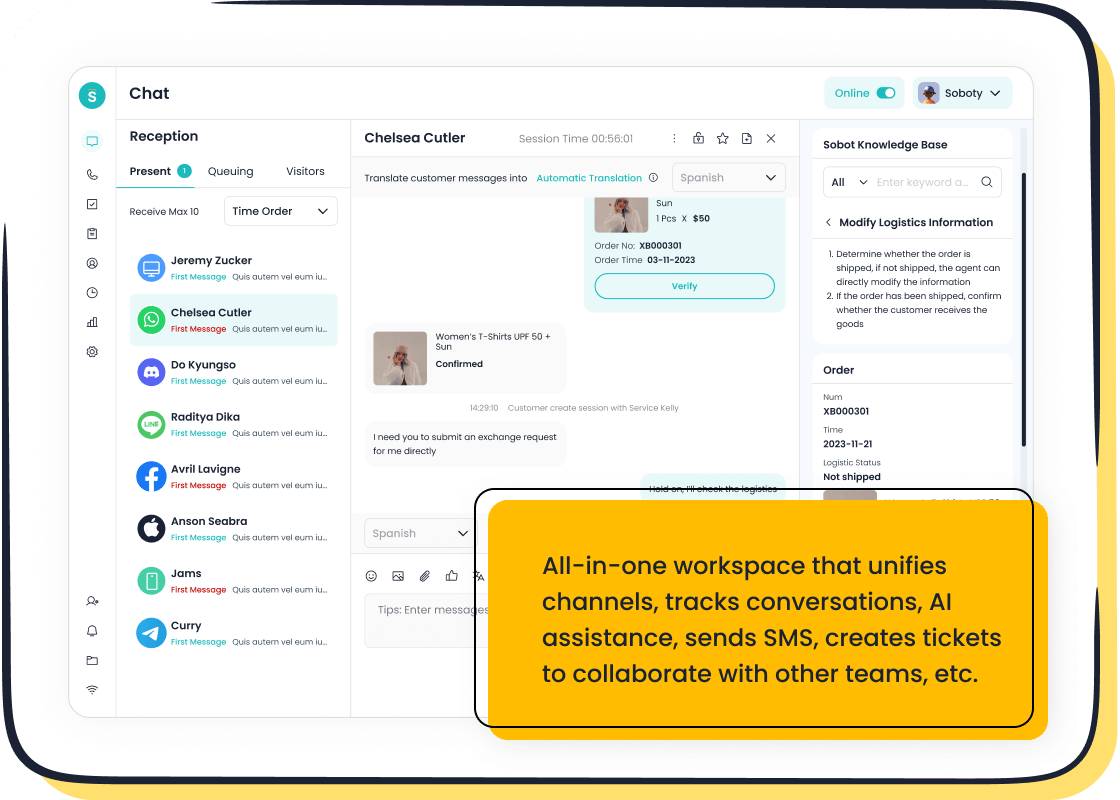
Sobot Live Chat exemplifies this trend by using precise profiling and customer segmentation to deliver personalized experiences across every channel. The platform’s AI tools analyze customer data, preferences, and behaviors to recommend relevant products or solutions. This approach leads to a 38% gain in conversion rates and fosters long-term loyalty.
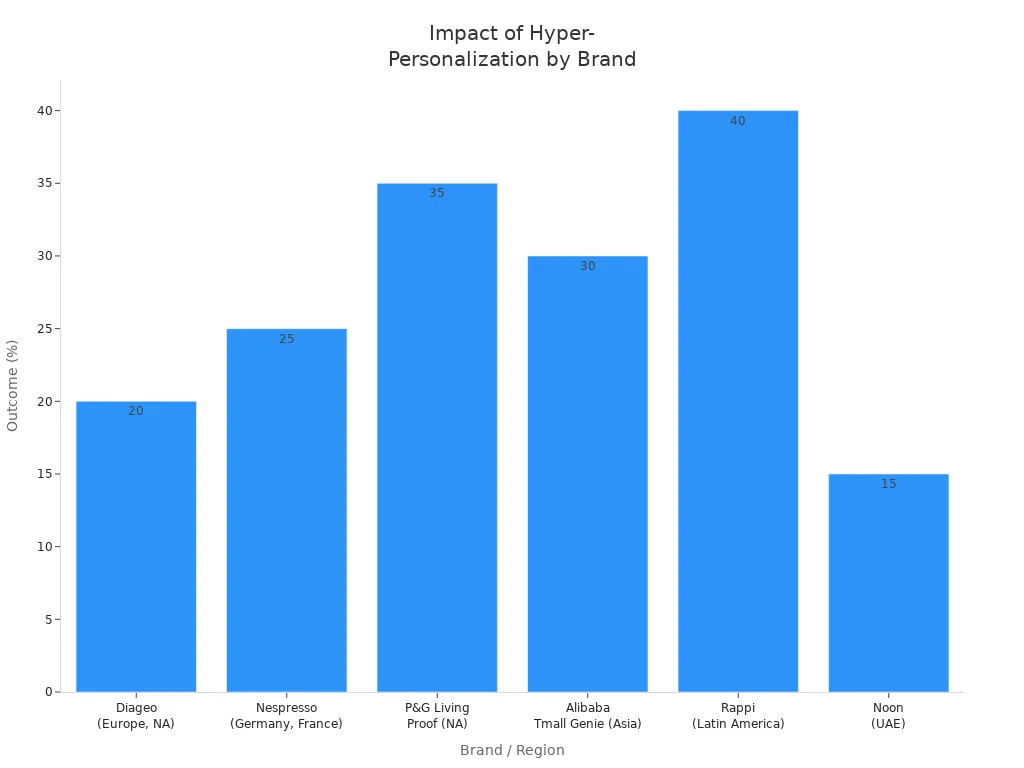
Global brands have seen impressive results from hyper-personalization:
| Brand / Region | Hyper-Personalization Initiative | Outcome / Metric |
|---|---|---|
| Diageo (Europe, NA) | Whisky recommendation tool using flavor preference quiz | Online engagement increased by over 20% |
| Nespresso (Germany, France) | Personalized emails based on purchase history | 25% higher email open rates, driving repeat purchases |
| P&G Living Proof (North America) | Hyper-personalized subscription service using CRM and e-commerce data | 35% increase in retention rates |
| Alibaba Tmall Genie (Asia) | Smart speaker with personalized shopping lists and reminders | 30% increase in repeat purchases during Chinese New Year |
| Rappi (Latin America) | Real-time analytics for personalized recommendations during FIFA World Cup | 40% sales surge in Brazil and Argentina |
| Noon (UAE) | AI-driven personalized product recommendations | 15% reduction in cart abandonment |
According to McKinsey, hyper-personalization can reduce customer acquisition costs by as much as 50%, increase revenues by 5-15%, and improve marketing ROI by 10-30% (source). When customers feel understood and valued through personalized communication, they are more likely to engage, make repeat purchases, and develop lasting loyalty. Sobot’s unified workspace and AI-powered tools ensure every customer receives tailored, context-aware service, strengthening relationships and differentiating brands in a crowded market.
Proactive Engagement
Proactive customer engagement is another major trend shaping the future of CX. Brands no longer wait for customers to reach out with questions or complaints. Instead, they use predictive analytics and AI to anticipate needs, offer timely support, and deliver value before issues arise. This shift increases customer satisfaction, loyalty, and lifetime value.
Key predictions for proactive engagement include:
- Proactive outreach strategies will gain importance as a means to boost customer loyalty and engagement.
- Collecting and analyzing customer data helps tailor engagement efforts to improve customer lifetime value.
- Prompt responses to customer queries and complaints on social media build trust and defuse negativity.
Sobot’s Live Chat platform enables proactive engagement by monitoring customer behavior, sending targeted messages, and offering real-time assistance. For example, if a customer lingers on a checkout page, the system can trigger a personalized offer or connect them with an agent. This approach increases purchase frequency, accelerates the sales funnel, and encourages repeat visits.
84% of consumers say they would remain loyal to a brand offering a loyalty program, and 66% state that rewards influence their spending (source). Proactive engagement strategies, such as rewards and referral programs, incentivize continued spending and advocacy.
Positive brand perception also grows through proactive engagement. Customers who receive timely, relevant support develop stronger emotional connections with brands. These connections lead to higher retention, increased share of wallet, and greater advocacy. Sobot’s analytics-driven platform tracks key CX metrics, such as Net Promoter Score (NPS) and sentiment analysis, to help brands refine their engagement strategies and deliver exceptional experiences at every touchpoint.
Proactive engagement is not just a trend—it is a strategic imperative for brands seeking to maximize customer lifetime value and build lasting loyalty.
Omnichannel Integration

Seamless Journeys
A seamless omnichannel customer journey connects every touchpoint, making each interaction feel natural and connected. Customers expect to move from social media to email, website, or even offline stores without repeating themselves. Businesses that deliver this experience see strong results. For example, companies with an effective omnichannel strategy retain 89% of their customers, compared to just 33% for those without one. Research shows that 73% of consumers use multiple channels during their shopping journey, and seamless transitions can increase conversion rates by up to 10%.
| Customer Experience Metric | Average Improvement Range | Business Impact |
|---|---|---|
| Conversion Rate | +10-20% | Increased Sales |
| Average Order Value | +5-15% | Higher Revenue Per Customer |
| Customer Lifetime Value | +15-30% | Improved Long-Term Profitability |
| Customer Churn Rate | -5-15% | Reduced Customer Loss |
These numbers highlight how omnichannel customer experience drives business growth and loyalty. Consistent messaging and personalized communication across all channels build trust and make every journey memorable.
Unified Workspaces
Unified workspaces play a key role in delivering true omnichannel personalization. When agents access all customer data, profiles, and past interactions in one place, they respond faster and with more accuracy. This setup reduces errors and shortens response times. Agents no longer need to switch between systems, which increases productivity and improves the overall experience.
Unified workspaces also support real-time analytics and intelligent routing. AI-driven features help agents focus on complex issues while automation handles routine tasks. Managers benefit from centralized dashboards, making it easier to monitor performance and allocate resources. This approach leads to higher customer satisfaction and more efficient operations.
Sobot Omnichannel Solution
Sobot’s Omnichannel Solution brings all these benefits together. The platform integrates voice, chat, email, and social media into a single, unified workspace. Agents see every customer journey in one view, allowing for seamless transitions and personalized service. Sobot’s AI-driven automation handles repetitive queries, freeing agents to solve more complex problems.
A real-world example comes from Opay, a leading financial service platform. Opay used Sobot’s solution to unify its customer service across social media, email, and voice channels. As a result, Opay increased its customer satisfaction rate from 60% to 90%, reduced operational costs by 20%, and boosted conversion rates by 17%. The unified platform allowed Opay to manage high volumes of inquiries efficiently and deliver a consistent, high-quality experience at every touchpoint (source).
Omnichannel integration is not just a trend. It is a proven way to improve customer loyalty, increase sales, and drive long-term business success.
Voice, Conversational AI, and Community

Voice and Chatbots
Voice and chatbot technologies have become essential tools for delivering effective customer service. Many organizations now invest in these solutions to improve response times and provide consistent support. The adoption rate continues to rise across industries, with over 50% of organizations implementing or planning to implement chatbots. In banking and financial services, chatbots hold a 23% market share, while retail and healthcare sectors also show strong adoption. More than 8.4 million businesses use voice assistants, reflecting steady growth.
| Industry Sector | Adoption Rate / Statistic | Additional Insight |
|---|---|---|
| General Organizations | Over 50% have implemented or are implementing chatbots | Indicates broad adoption across industries |
| Banking, Financial Services, Insurance (BFSI) | 23% market share in chatbot adoption (2024) | Used for lead generation, payment processing, and customer support |
| Healthcare | 21% of Americans used chatbots for health topics recently | Healthcare chatbot market valued at $235M in 2023, projected to grow at 20.1% CAGR to 2032 |
| Retail and eCommerce | 21% market share of global conversational AI market | 66% US consumers interested in GenAI conversational commerce; 47% use chatbots for orders |
| Voice Assistants | Over 8.4 million businesses using voice assistance (2024) | Growing steadily with 2.9% year-over-year growth |
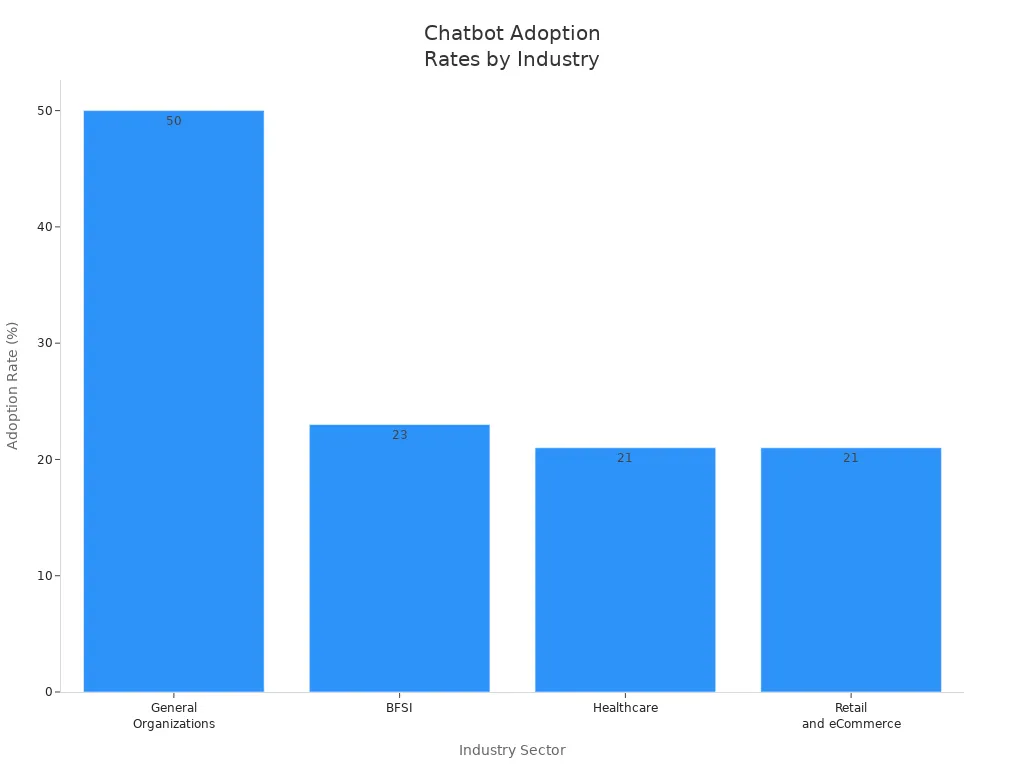
Sobot’s AI-powered voice and chatbot solutions help brands deliver fast, accurate answers and support on every channel. These tools enable businesses to offer personalization at scale, ensuring customers receive relevant information and assistance.
Conversational AI
Conversational AI transforms how companies interact with customers. It uses natural language processing to understand intent and resolve issues quickly. For example, a Texas Bank saw its first-contact resolution rate rise by 16% after deploying voice AI, which led to fewer repeat calls and over $1.4 million in cost savings. Customer satisfaction scores improved by 17%. Conversational AI systems automate routine queries, provide intelligent routing, and support agents with real-time insights. This technology empowers agents to focus on complex problems and deliver more personalized experiences.
Conversational AI not only improves operational efficiency but also boosts customer satisfaction by resolving issues on the first contact.
Sobot’s omnichannel platform integrates conversational AI, allowing businesses to deliver seamless, personalized support across voice, chat, and messaging channels.
Building Customer Communities
Strong customer communities drive brand loyalty and advocacy. Brands identify potential advocates by monitoring social media and feedback, then personalize interactions to build relationships. Gamification and loyalty programs can boost engagement by up to 60%. Active listening and transparent communication help brands earn trust and foster a sense of belonging.
| Proven Benefits of Building Customer Communities for Brand Advocacy and Support | Explanation |
|---|---|
| Enhances credibility | Advocates lend authenticity and build trust, increasing likelihood of customer conversion. |
| Brand affirmation | Positive experiences shared by advocates act as testimonials, solidifying brand reputation. |
| Increased organic reach | Word-of-mouth and organic promotion by advocates expand brand reach to new audiences. |
| Cost-effective marketing | Advocates promote the brand willingly, reducing need for expensive campaigns. |
| Improved customer retention | Recognizing advocates fosters loyalty and sustained relationships. |
Over 50% of consumers are more likely to recommend a brand if they receive rewards or recognition. Sobot’s unified workspace supports community building by enabling brands to track engagement, respond to feedback, and deliver personalized experiences that turn customers into passionate advocates.
Data Privacy and Trust
Privacy Regulations
Global privacy regulations now shape every multichannel cx strategy. Laws such as GDPR and CCPA require companies to get explicit consent, minimize data collection, and maintain transparency. These rules change how businesses collect, store, and use data across channels. Companies must track consent, manage data erasure requests, and update privacy policies regularly. The following list highlights key requirements:
- Obtain clear consent before collecting personal data.
- Limit data collection to what is necessary for the cx.
- Maintain transparency about data usage and storage.
- Provide customers with the right to access or delete their data.
- Use robust consent management systems.
- Replace third-party cookies with first-party data strategies.
- Partner only with vendors who meet compliance standards.
Brands that respect privacy can build stronger relationships and gain a competitive edge. Privacy-centric technologies, such as Consent Management Platforms, are becoming essential for compliance and trust.
Trust and Loyalty
Trust forms the foundation of every successful cx. Studies show that 76% of consumers avoid companies they do not trust with their data, and 81% believe data handling reflects how a company values its customers (source). When companies comply with privacy laws, they show commitment to protecting customer information. Transparency and strong security measures reassure customers and encourage them to share data. This trust leads to higher engagement, stronger customer loyalty programs, and positive word-of-mouth. Customers who trust a brand are more likely to participate in cx initiatives and share valuable feedback. Companies that embed privacy into their culture see long-term benefits in loyalty and reputation.
Sobot’s Security Standards
Sobot sets high standards for data protection in every customer interaction. The platform uses federated learning to keep sensitive data localized, reducing breach risks. Sobot applies 256-bit AES encryption for voice AI agent calls, meeting HIPAA compliance. Differential privacy techniques and secure APIs protect data during every stage of the cx. Sobot complies with major regulations, including GDPR and HIPAA, and conducts regular privacy checks. Staff receive ongoing training to maintain security awareness. These measures have resulted in a 95% customer satisfaction rate and a 25% cost reduction for clients like Agilent. Sobot’s commitment to privacy and security helps brands build trust, drive customer loyalty, and deliver a superior experience across all channels.
Immersive and Ethical Trends
AR/VR in Customer Experience
Augmented reality (AR) and virtual reality (VR) are shaping new predictions for how brands engage with customers. These technologies create immersive experiences that blend digital and physical worlds. Leading brands use AR and VR to boost engagement, increase purchase confidence, and drive memorable interactions. The table below highlights how top companies apply these innovations:
| Brand | AR/VR Application | Customer Experience Enhancement |
|---|---|---|
| American Express | VR immersive fan experiences at U.S. Open and Coachella; interactive VR games; shoppable AR features in event apps | Creates engaging, memorable experiences that increase brand engagement and social media sharing |
| Ikea | Ikea Place app allowing virtual furniture placement with 98% accuracy | Helps customers visualize products in their own space, increasing purchase confidence and reducing uncertainty |
| The New York Times | VR films and AR-enabled articles providing immersive storytelling experiences | Enhances storytelling by immersing readers in the story environment, increasing engagement and emotional connection |
| Gucci, Nike, BMW, PacSun | Virtual try-ons, interactive in-store displays, virtual showrooms, remote assistance | Increases personalization, convenience, and engagement, bridging physical and digital shopping experiences |
AR enables 360-degree product visualization, allowing customers to interact with products before buying. Brands like BMW use AR-powered remote assistance to provide real-time support, which improves first-call resolution rates by 35%. Social media platforms also integrate AR, helping brands like Gucci reach younger audiences and deepen loyalty. These predictions show that immersive technology will continue to drive personalization and engagement in the coming years.
Human-AI Collaboration
Human-AI collaboration stands at the center of future predictions for customer service. Teams that combine human expertise with AI tools see measurable improvements in productivity, conversion, and customer satisfaction. The chart below shows the impact of this collaboration:
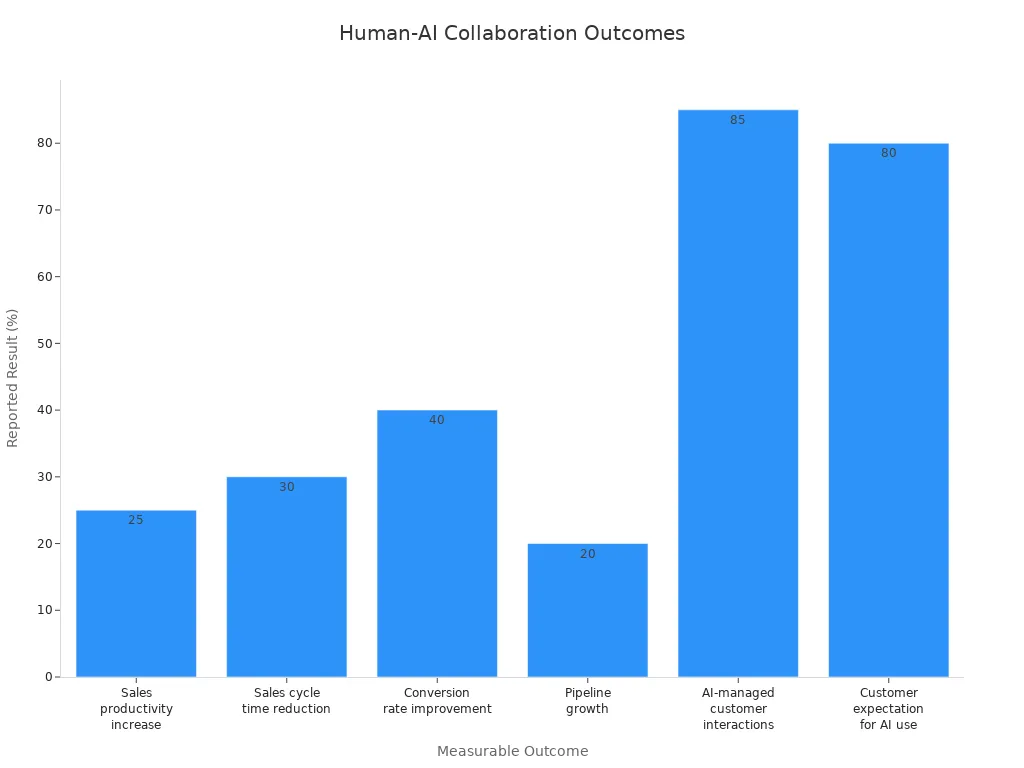
Companies using AI platforms report a 25% increase in sales productivity and a 30% reduction in sales cycle time. IBM saw a 40% improvement in conversion rates and 20% pipeline growth after integrating AI into their workflows. Predictions indicate that by 2025, AI will manage 85% of customer interactions, with 80% of customers expecting AI-driven personalization. Sobot’s unified workspace and AI-powered tools help agents deliver fast, accurate, and personalized support, optimizing both efficiency and customer experience. This collaboration not only saves time but also strengthens relationships and drives positive ROI.
Sustainability and Ethics
Sustainability and ethical practices have become central to customer expectations and brand predictions. Consumers now demand transparency, responsible sourcing, and environmental stewardship. Recent data shows that 79% of people want easier ways to identify eco-friendly companies, while 88% prioritize buying from brands with ethical sourcing. Millennials and Gen Z lead these trends, with 60% willing to pay more for sustainable products and 64% ready to stop buying from companies linked to unethical suppliers.
- Customers prefer brands that show environmental and social responsibility.
- Younger generations value transparency and ethical sourcing, influencing purchase decisions.
- Corporate social responsibility (CSR) policies improve brand reputation and foster loyalty.
- Sustainable marketing aligns with global goals and creates long-term value.
Sobot supports these predictions by providing secure, scalable solutions that help brands build trust and meet evolving ethical standards. Companies that embrace sustainability and ethics not only enhance their image but also deepen customer loyalty and drive sustainable growth.
Brands face an urgent need to embrace multichannel customer experience trends.
- Omnichannel engagement drives 250% higher purchase rates and 90% higher retention.
- AI-driven personalization can generate 40% more revenue and triple growth for companies prioritizing experience.
- Customers expect seamless, personalized journeys across every channel.
Companies should review their current approach by mapping customer touchpoints, defining desired outcomes, and building a roadmap for improvement. Sobot’s unified platform empowers organizations to deliver consistent, data-driven service and foster lasting loyalty. Continuous innovation and a customer-centric mindset will help brands thrive in a rapidly changing market.
FAQ
What is a multichannel customer experience, and why does it matter in 2025?
A multichannel customer experience connects customers with brands across channels like chat, voice, email, and social media. In 2025, 73% of consumers expect seamless transitions between channels. Companies using unified solutions like Sobot see higher satisfaction and loyalty.
How does AI improve multichannel customer experience?
AI automates routine tasks, analyzes customer data, and personalizes interactions. Sobot’s AI-powered platform reduces response times by 37% and increases conversion rates by 38%. Brands using AI in customer experience report up to 30% higher customer lifetime value.
Why is omnichannel integration important for customer service?
Omnichannel integration unifies all customer touchpoints. This approach ensures consistent messaging and faster support. Sobot’s Omnichannel Solution helped Opay raise satisfaction from 60% to 90% and cut costs by 20%. Unified data improves both agent productivity and customer experience.
How does Sobot ensure data privacy and security in customer interactions?
Sobot uses 256-bit AES encryption, federated learning, and complies with GDPR and HIPAA. These measures protect customer data across all channels. Regular privacy checks and staff training help maintain high security standards, supporting trust in every multichannel customer experience.
What trends will redefine multichannel customer experience in the next few years?
Key trends include AI-driven automation, hyper-personalization, omnichannel integration, and proactive engagement. Brands adopting these trends, like Sobot’s clients, see higher retention and revenue. Industry data shows that companies prioritizing customer experience can achieve up to 40% more revenue (source).
See Also
How To Successfully Deploy Omnichannel Contact Center Systems
Comprehensive Overview Of Omnichannel Call Center Platforms
Best Contact Center Technologies Evaluated For 2024
